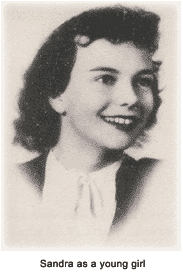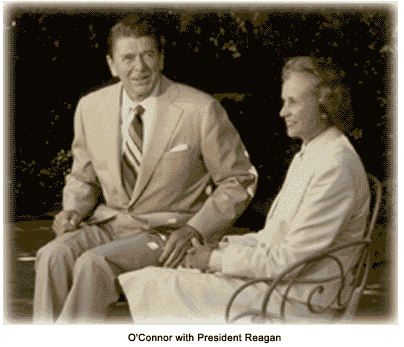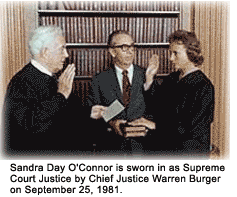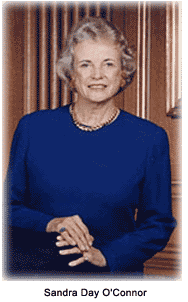From Arizona cowgirl to a seat on the Supreme Court of the United States is a heady jump for a small-town girl. Aside from being the first woman and 102nd person chosen for the highest court in the land, Sandra Day O`Connor will be remembered for being the decisive vote in close decisions preserving the separation of church and state, upholding abortion rights, and allowing universities to adopt Affirmative Action policies that favor minority applicants.
Her personal life included such disparate thrills as being named an honorary member of the Cowgirl Hall of Fame in Fort Worth, Texas; stroking a hole-in-one on a golf course in her home state; and making an impromptu appearance as Queen Isabel in a Shakespeare Theater`s production of Henry V.
 The early years
Sandra Day, born in March 1930, grew up on an isolated southeastern Arizona cattle ranch, the "Lazy B," near the town of Duncan, pop. 800. She was graduated from Stanford University with a degree in economics, then earned her L.L.B. from Stanford Law School. In 1952, she finished third out of 102 students in the same class as William Rehnquist, later to be a chief justice, who was the undisputed number one.
She completed her law degree in two years instead of the usual three, and served on the Stanford Law Review. Her top class standing earned O`Connor an invitation to the "Order of the Coif," an elite group of attorneys that were in the top 10 percent of their classes. Six months after graduation, in December 1952, she married John O`Connor.
During the early 1950s, it was difficult for women to find any meaninful, well-paid positions, and it was no different for O`Connor, even with her impeccable credentials. Her only offer from a California law firm was as a legal secretary. Sandra accompanied John to Germany when he was drafted into the Judge Advocate General Corps, and she signed on with the Quartermasters Corps as a civilian attorney.
When John was discharged from the Army, the O`Connors decided to settle down in the Phoenix area in 1957. In the next six years, they had three sons. Once again, work was scarce. She decided to start her own law firm with a single partner.
O`Connor managed by handling a number of small, diverse cases. Her children needed more attention after her second son`s birth, so she temporarily withdrew from her firm. O`Connor found time to volunteer at the Arizona State Hospital, the Salvation Army, and local schools. She also became involved with the Republican Party.
Following a five-year stint as a full-time mother, O`Connor found employment as an assistant state attorney general. Upon the resignation of a state senator, she was named to fill the vacant seat, holding it through two elections. A first for women, O`Connor became the majority leader.
In 1974, she decided to change the focus of her career by successfully running for a judgeship on the Maricopa County Supreme Court. In 1978, the state Republican party offered her a chance for a run at the governor`s spot, but she declined.
The early years
Sandra Day, born in March 1930, grew up on an isolated southeastern Arizona cattle ranch, the "Lazy B," near the town of Duncan, pop. 800. She was graduated from Stanford University with a degree in economics, then earned her L.L.B. from Stanford Law School. In 1952, she finished third out of 102 students in the same class as William Rehnquist, later to be a chief justice, who was the undisputed number one.
She completed her law degree in two years instead of the usual three, and served on the Stanford Law Review. Her top class standing earned O`Connor an invitation to the "Order of the Coif," an elite group of attorneys that were in the top 10 percent of their classes. Six months after graduation, in December 1952, she married John O`Connor.
During the early 1950s, it was difficult for women to find any meaninful, well-paid positions, and it was no different for O`Connor, even with her impeccable credentials. Her only offer from a California law firm was as a legal secretary. Sandra accompanied John to Germany when he was drafted into the Judge Advocate General Corps, and she signed on with the Quartermasters Corps as a civilian attorney.
When John was discharged from the Army, the O`Connors decided to settle down in the Phoenix area in 1957. In the next six years, they had three sons. Once again, work was scarce. She decided to start her own law firm with a single partner.
O`Connor managed by handling a number of small, diverse cases. Her children needed more attention after her second son`s birth, so she temporarily withdrew from her firm. O`Connor found time to volunteer at the Arizona State Hospital, the Salvation Army, and local schools. She also became involved with the Republican Party.
Following a five-year stint as a full-time mother, O`Connor found employment as an assistant state attorney general. Upon the resignation of a state senator, she was named to fill the vacant seat, holding it through two elections. A first for women, O`Connor became the majority leader.
In 1974, she decided to change the focus of her career by successfully running for a judgeship on the Maricopa County Supreme Court. In 1978, the state Republican party offered her a chance for a run at the governor`s spot, but she declined.
 About two years later, Ronald Reagan came calling to fulfill a campaign promise to place a woman on the U.S. Supreme Court.
In February 2005, O`Connor became the first woman to preside over oral arguments before the Supreme Court (Kelo v. City of New London). That happened when Chief Justice Rehnquist and Associate Justice Stevens (the only other senior justice) were absent.
O`Connor`s decisions
Due to her association with the Republican Party, observers tended to associate O`Connor with the conservative wing of the court, having values that were akin to then Associate Justice Rehnquist. That pigeon-holing generality was only partly correct.
It soon became evident that O`Connor had a mind of her own, proving to be more centrist than polarized.
Perhaps her most important decision concerned Grutter v. Bollinger (June 1993), when she upheld the constitutionality of the University of Michigan Law School`s Affirmitive Action program as long as each application was processed individually.
O`Connor sided with conservatives as the "Federalism Revolution" gained momentum. That movement shifted some of the power that The New Deal of the Franklin D. Roosevelt adminstration had usurped, back to the states. The court positioned itself as the moderate arbitrator between two divergent factions.
About two years later, Ronald Reagan came calling to fulfill a campaign promise to place a woman on the U.S. Supreme Court.
In February 2005, O`Connor became the first woman to preside over oral arguments before the Supreme Court (Kelo v. City of New London). That happened when Chief Justice Rehnquist and Associate Justice Stevens (the only other senior justice) were absent.
O`Connor`s decisions
Due to her association with the Republican Party, observers tended to associate O`Connor with the conservative wing of the court, having values that were akin to then Associate Justice Rehnquist. That pigeon-holing generality was only partly correct.
It soon became evident that O`Connor had a mind of her own, proving to be more centrist than polarized.
Perhaps her most important decision concerned Grutter v. Bollinger (June 1993), when she upheld the constitutionality of the University of Michigan Law School`s Affirmitive Action program as long as each application was processed individually.
O`Connor sided with conservatives as the "Federalism Revolution" gained momentum. That movement shifted some of the power that The New Deal of the Franklin D. Roosevelt adminstration had usurped, back to the states. The court positioned itself as the moderate arbitrator between two divergent factions.
 Other decisions and positions included:
Other decisions and positions included:
 Epilogue
On July 1, 2005, Sandra Day O`Connor submitted her intent to retire upon the selection of her replacement. Upon leaving the Supreme Court, O`Connor bequeathed a legacy of moderation and common sense. She was said to be a no-nonsensical, get-to-the-point justice when asking, often, the first question of the presenting attorneys during oral arguments.
Epilogue
On July 1, 2005, Sandra Day O`Connor submitted her intent to retire upon the selection of her replacement. Upon leaving the Supreme Court, O`Connor bequeathed a legacy of moderation and common sense. She was said to be a no-nonsensical, get-to-the-point justice when asking, often, the first question of the presenting attorneys during oral arguments.